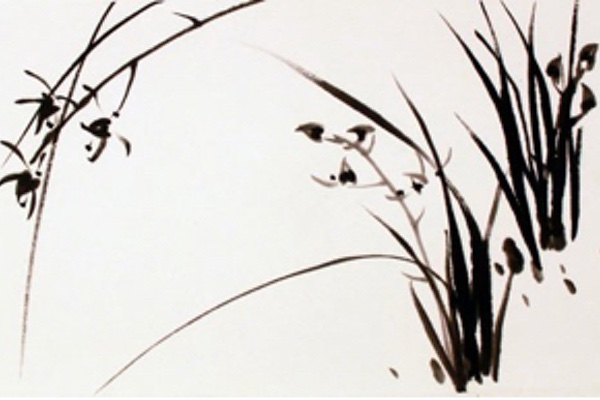By Sungsook Hong Setton

The plum blossom, orchid, chrysanthemum, and bamboo are considered the four noble (‘gentlemen’) plants. When I studied with Master Chang in the 1980s I was restricted to learning only one stroke per month of study. The orchid leaf stroke was first, and he did not teach me anything else until I nearly perfected that stroke. After that, I learned how to paint the orchid flowers. As difficult as it is to paint orchids, it is even more difficult to paint the orchid’s fragrance.
The essence of the orchid is expressed with the qi of the strokes. According to the celebrated eighteenth-century Korean calligrapher and painter Kim Junghi (pen name: Ch’usa), without excellent calligraphic skills and brush strokes full of vitality, it is almost impossible to depict orchids well.
Although I often practiced orchid strokes, I rarely liked my work. I decided to keep this one and called it “Tao of Orchid,” because it seemed to preserve a good balance in terms of space and also manifested high energy. Externally, orchids are delicate and gracious plants. However, in this painting, I strove to capture an internal aspect, which I value in fall orchids and depict just a few blooms on one stalk. The colored flowers contrast with the strong dark leaves.
It is said that Confucius originally drew attention to this delicate plant, exclaiming: “With a fragrance fit for princes, why are you buried among the common weeds?” From olden times the appearance of the wild orchid, which grew deep in the mountains, was compared to the mind of a noble and cultivated scholar bureaucrat, who had transcended the greed and fame-seeking of the secular world. Therefore many exiled Korean literati enjoyed painting the orchid. The orchid is known as a symbol of purity and noble virtue due to its fragrance. This symbolism goes back to the Ch’in dynasty of the third century. Ch’u Yuan, a patriotic poet, regarded the orchid as a mirror of one’s moral life.
The rarity and uniqueness of the orchid is vividly expressed in these two poems which I have translated:
세상이어수선해도
한분난을바라봄으로
모든상념
잊을수있네
Even though the world is filled with confusion
When I gaze at one orchid
I can forget
all my problems.
— Song Sunam (Lee, Oryung. The Orchid. p59)
낭떠러지에온갖풀말랐는데
난초는오히려생기가돋아난다
군자는험악한곳에살면서도
보통사람과다르지않은가
On the dark cliff hundreds of weeds are withering
And yet the orchid bounds with vigor
The noble person dwells in steep, isolated places
He is indeed different from normal people
— Chen Hsie n Chang (Ming dynasty)
As one of the four noble plants, the orchid is often the subject of poems as well as of water-ink paintings. The concept of the “four noble plants” first appeared in the work of Gin Keyu (1558–1639) and specifically his record of four plants. Before this, there were only two categories of subjects, “landscape” and “birds and flowers.” Although individual noble plants were depicted earlier, from the Ming dynasty onward, the “four noble plants” became a new genre in Chinese literati art. These four noble plants became the foundation of brushwork as well as embodying East Asian principles of modeling and aesthetic philosophy.
This pastime of the scholar-bureaucrats reflected their classical and aristocratic taste and was referred to as “ink play.” Water-ink technique, which uses black ink ground on an ink stone with an ink stick, arose in China during the eighth century. Two centuries later, it became a principal art form in China. Over the next three hundred years, the discipline of painting the four noble plants spread from China to its neighbors Korea and Japan, where it was influenced by Ch’an (Zen) Buddhism and became equally popular.
In East Asian water-ink painting, the subjects usually have some kind of hidden symbolic meaning. As Pierre Cambon describes: “The ‘four noble plants’ refer to Confucian ideology while also suggesting the rhythm of the seasons and passage of time. Bamboo, always green, bends without breaking and symbolizes loyalty and fidelity. The prune bears flowers before the snows melt and suggests the rebirth of spring. The orchid evokes a world of beauty, and fragile, delicate harmony. Chrysanthemums bloom in the fullness of autumn. But these subjects are also closely linked to calligraphy and brushwork, and handwriting is considered to reflect the author’s cultivation and personality.”
According to Francis Mullany, there is no systematic relationship between the four noble plants and the four seasons. On the other hand, due to differences of climate and geography, artists and writers from China and Korea associate specific plants with specific seasons. For instance, in China the bamboo is symbol of summer; whereas in Korea symbolizes winter. Furthermore, in China the orchid is associated with spring whereas in Korea it is associated with summer.
Originally published on sungsooksetton.com.

